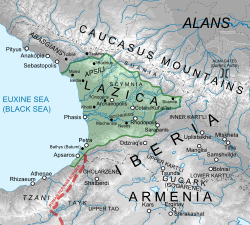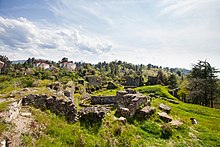Lazic War
| Lazic War | |||||||||
|---|---|---|---|---|---|---|---|---|---|
| Part of the Byzantine–Sasanian wars | |||||||||
 Map of Lazica | |||||||||
| |||||||||
| Belligerents | |||||||||
| Commanders and leaders | |||||||||
|
Justinian I John Tzibus † Dagisthaeus Bessas Martin Valerian Bouzes Belisarius Justin Gubazes II of Lazica (after 548) Dabragezas Elmingir |
Khosrow I Mihr-Mihroe Nachoragan Nabedes Farroxan[2] Izadgushasp Fariburz Gubazes II of Lazica (541–548) Opsites of Lazica Terdetes[3] | ||||||||
The Lazic War, also known as the Colchidian War or in Georgian historiography as the Great War of Egrisi
Lazica
Lazica, situated on the eastern shore of the
Lazica featured a difficult terrain and was surrounded by naturally impregnable borders. Besides, it was protected by strong fortresses, including
Background
The Persian
War

Those calls were answered that year by the Persian king Khosrow I, who entered Lazica, captured the Byzantine main stronghold of Petra, and established another protectorate over the country.[9] Khosrow I retreats to Persia a year later after an abortive invasion of Commagene. In 543, a Roman invasion of Armenia was defeated by a small Persian force at Anglon, and Khosrow I unsuccessfully besieges Edessa in Mesopotamia a year later. A peace treaty is signed in 545.[10]



In Lazica, Khosrow I's attempt to establish direct Persian control over the country and the missionary zeal of the
King Gubazes quarreled with Byzantine commanders
Outcome
Then, in 557, a truce ended the hostilities between the Byzantines and Persians, and by the "Fifty Years Peace" of Dara of 562, The Byzantine Empire was obliged to pay tribute to Persia each year for the recognition of Lazica as a Roman vassal state. Although no clear winner emerged from the conflict, the Sasanian Empire thus held a slight advantage since Rome was required to pay a set amount to Persia annually.[11]
See also
References
- ^ The Persian Empire: A Historical Encyclopedia (2 volumes): A Historical... Archived 28 March 2018 at the Wayback Machine. "When the war finally ended, the Lazica victorious forced the Byzantine emperor to pay 400 gold pounds a year
- ^ Alemany 2003, p. 5.
- ISBN 978-1-78656-373-6.
- ^ Georgian: ეგრისის დიდი ომი Egrisis Didi Omi
- ISBN 978-90-04-49877-8.
After 545 truces brought peace to most of the border regions, but the war lingered in the Caucasus until 561, when Khosrow and Justinian finally agreed to a fifty-year peace. There was no definite victor, but the Sasanian Empire was in a slightly better position as Rome was obliged to pay a fixed sum to Persia each year.
- ^ Salia 1980, p. 113
- ISSN 2449-2671.
- ^ Salia 1980, p. 114
- ^ Martindale, Jones & Morris 1992, pp. 559, 639; Bury 1958, pp. 101–102.
- ISBN 978-1-108-08317-1.
- ISBN 978-90-04-49877-8.
After 545 truces brought peace to most of the border regions, but the war lingered in the Caucasus until 561, when Khosrow and Justinian finally agreed to a fifty-year peace. There was no definite victor, but the Sasanian Empire was in a slightly better position as Rome was obliged to pay a fixed sum to Persia each year.
Sources
- Alemany, Agustí (2003). "Sixth Century Alania: Between Byzantium, Sasanian Iran and the Turkic World" (PDF). Transoxiana: Journal Libre de Estudios Orientales (Transoxiana Webfestschrift Series): 1–8.
- Salia, Kalistrat (1980). Histoire de la nation géorgienne. Nino Salia.
- ISBN 0-486-20399-9.
- Hughes, Ian (2009). Belisarius: The Last Roman General. South Yorkshire: Pen & Sword Military. ISBN 9781844158331.
- Martindale, John Robert; Jones, Arnold Hugh Martin; Morris, J., eds. (1992). The Prosopography of the Later Roman Empire, Volume III: A.D. 527–641. Cambridge, United Kingdom: Cambridge University Press. ISBN 978-0-521-20160-5.
